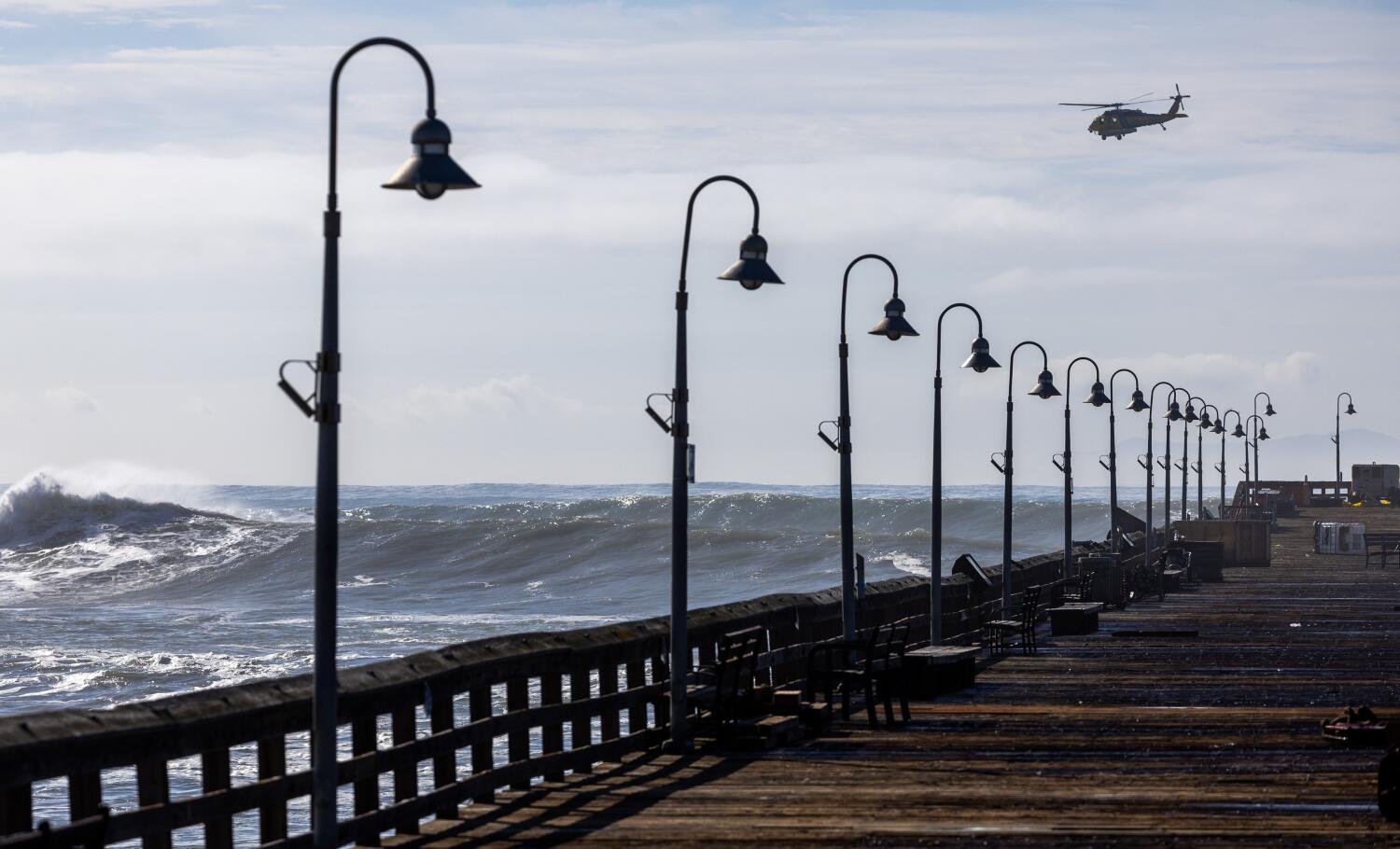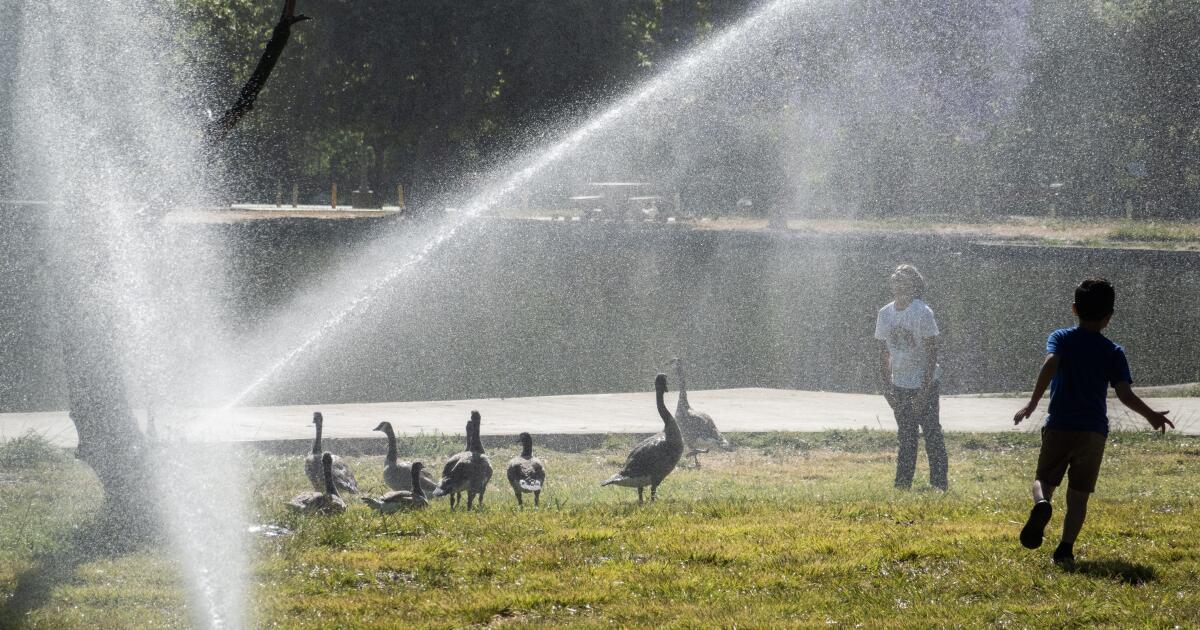World News
State recalls West Coast Cure vape months after contamination reported

California cannabis regulators on Tuesday issued the state’s first recall of a pesticide-tainted weed product following a Los Angeles Times investigation disclosing dangerous contamination in the state’s legal cannabis supplies.
The product ordered pulled from sale is an “Orange Cookies”-flavored West Coast Cure vape cartridge produced in September. The state recall said the vape exceeded safety limits for a single chemical, the insecticide chlorfenapyr.
The Department of Cannabis Control did not immediately disclose how many of the vapes remained on store shelves, but posted online a list of 169 locations throughout the state where the product had been sold. The product’s safety certificate came from a lab whose license has since been suspended. That lab, Verity Analytics, reported the batch consisted of nearly 5,000 vapes.
It was among a dozen West Coast Cure batches manufactured in September — consisting of more than 62,000 vapes in assorted flavors — that private lab Infinite Chemical Analysis tested last fall and reported to state regulators as containing pesticides that exceeded state limits. All had been certified as safe by other labs.
Infinite reported the Orange Cookies batch in a complaint to the state in November. In addition to chlorfenapyr, the lab identified two additional chemicals in that batch: paclobutrazol, a growth hormone not allowed at any level, and trifloxystrobin, which showed up at four times what California deems safe.
State regulators would not say why they did not flag the product for the additional chemicals. The state also did not immediately respond to questions about why it took seven months to recall a product reported for safety concerns.
“It’s a symbolic recall,” said Elliot Lewis, owner of the 27-store Catalyst dispensary chain. Twenty-three of his stores carried the recalled vape. They sold out months ago, he said.
Lewis posted news of the recall on social media, provoking heated comments that left him flustered.
“Getting slammed,” he said. “First time I can remember going home unplanned [in the] middle of the day.”
The owner of another large dispensary chain said its stores had two of the products still in inventory but pulled them from shelves last week after their inclusion in an investigation by The Times, in conjunction with industry newsletter WeedWeek, that found alarming levels of pesticide contamination in cannabis products available to consumers, including some of the most popular brands.
That June 14 report showed 25 out of 42 products bought from licensed stores exceeded either state safety limits or federal tobacco standards. The results mirrored 85 contamination complaints filed with California regulators since October by Infinite and another whistleblower, Anresco Laboratories.
Before Tuesday, regulators had issued pesticide-related recalls for only two of the products that were the subject of the complaints.
West Coast Cure is California’s fourth-top-selling cannabis brand. Its parent company, Shield Management Group, this year was fined $3.2 million by California regulators after a surprise inspection found it had failed to guard against product tampering, such as storing cannabis products in parking lot containers without video surveillance. The company also could not produce state-required footage proving products had not been tampered with before lab testing or distribution.
West Coast Cure co-founder Logan Wasserman did not immediately respond to a request for comment regarding the recall.
A statement to The Times on Tuesday by a public relations firm on behalf of the company said: “We have passing test results from state licensed labs for every product we put on the market. Our dedication to excellence and doing what’s right for our customers and our community is at the core of our values. We remain steadfast in our mission to provide fully tested, exceptional products and uphold the trust placed in us.”
In federal court Monday, Infinite and Anresco filed a lawsuit against 13 independent labs that test cannabis products for the weed industry, accusing them of manipulating test results in order to win business, while putting consumer health at risk. The civil suit cites product safety certificates issued by some of the labs for products later found to be contaminated, as well as Department of Cannabis Control findings cited in disciplinary reports.
Infinite also provided the testing behind a proposed class-action lawsuit filed June 14 in Orange County Superior Court against West Coast Cure, seeking redress for 23 vape flavors alleged to be contaminated with pesticides, including the Orange Cookies product recalled Tuesday.
“Whereas competition used to be healthy and revolved around quality, turnaround time and customer service, it has now devolved into a free-for-all, in which brands and laboratories agree, jointly, to ignore ‘safety fails’ … in an effort to hide the presence of dangerous chemicals, which otherwise would prevent the sale of these tainted goods,” the consumer complaint alleges.
Both cases were handled by Arkansas class-action attorney David Slade, whose litigation cases include filings against Apple, Best Buy stores, Target and Hobby Lobby.
Other weed industry leaders called for a crackdown on alleged “persistent testing fraud” by the private labs California relies upon to screen cannabis for harmful substances.
“The state’s continued failure to enforce against those who fail to comply — both inside and outside of the regulated market — has put the credibility of the entire adult-use market in peril, and now threatens the very consumers we aim to serve,” the California Cannabis Industry Assn. said in response to the report by The Times and WeedWeek.
Gov. Gavin Newsom’s office voiced confidence in his cannabis agency’s handling of contamination issues, saying it “supports DCC in developing innovative policies and effective implementation that advances and facilitates a well-regulated, legal, and safe market that benefits all Californians.”
California has struggled since creation of the recreational cannabis market in 2018 to set up a state lab to enforce limits on pesticides in weed products.
In 2021, the cannabis agency signed an $11-million, five-year contract with UC San Diego’s cannabis research program to create a state lab “in order to confirm that licensed testing laboratories are accurately and reliably testing cannabis goods,” budget filings and contract records show. Those documents describe the lab as intended to run tests for regulators with results available within five days.
Four years and $9 million in payments later, the San Diego lab is not certified to check pesticide levels, its accreditation record shows.
With consolidation of cannabis-related regulation under a single agency in 2021, the Department of Cannabis Control took over a cannabis lab in Richmond that had been run by the Department of Public Health. In the ensuing years, that lab has gained accreditation to test for potency levels and microbial contamination, but is not certified to measure pesticides.
In the interim, cannabis regulators are constrained by the limitations of other state labs that have sometimes agreed to test weed. The Agriculture Department lab, for instance, tested cannabis flower to identify the presence of smuggled Chinese-label pesticides. But the lab cannot assess the safety of vaping oils, in which contamination problems appeared greatest.
With state safety certificates called into question, one of California’s largest weed retailers, Catalyst, announced it would start its own shelf testing program. Lewis, its owner, voiced mixed feelings about what consumers would make of that. He said that he remained convinced that products sold on the illicit market are worse, and that lessening public confidence in the legal market would hurt brands producing clean products.
In an email, he said vape sales have dropped since the June 14 article. “I suspect more folks now see no benefit of shopping for legal products,” he wrote. “The customer’s thought process is, ‘It’s all dirty.’”
It is not good timing for a loss of faith in the legal market. Sales of licensed products have been in slipping in California since peaking in 2021 at $5.3 billion, according to monthly sales reports posted by the Department of Cannabis Control. The most recent data show reported sales of $4.9 billion for 2023.
The desire to convince California residents and tourists to purchase their cannabis in licensed and taxed shops has driven state marketing and data collection campaigns since 2020, including the $5-million “Real CA Cannabis” campaign that kicked off in February, featuring social media messages on Facebook, Instagram and Reddit targeted at key demographics.
“[F]or public health purposes, the state has an interest in seeing consumer behavior shift more swiftly to the legal and regulated market,” the cannabis control agency wrote in a 2022 budget request, citing deaths and injuries two years prior from dangerous substances in cannabis and tobacco vaping products.
In California alone, some 250 people were hospitalized and five died when the U.S. Centers for Disease Control and Prevention in 2019 linked a rise in lung-related injuries to vaping products, the cannabis agency wrote in its budget request.
World News
India Wins T20 Cricket World Cup, Stamping Its Domination of the Sport

India won the men’s Cricket World Cup on Saturday, defeating South Africa to end a dry spell in tournament victories that had lasted over a decade, even as the nation was dominating the sport globally in other measures like talent, cash and influence.
The tournament was played across several Caribbean islands, with a few of the matches hosted in the United States, including at a pop-up stadium in New York. When the final, in Barbados, ended with India declared the champion, it was close to midnight back home, where joyful crowds poured into the streets across several cities.
“Maybe in a couple hours it will sink in, but it is a great feeling,” said Rohit Sharma, India’s captain, who took a tour of the stadium with his daughter propped on his shoulders to thank the crowd. “To cross the line — it feels great for everyone.”
It was a closely fought match, and a deeply emotional one for India, in part because many of its senior players, including Sharma, 37, were near the end of their careers. India last won the World Cup in T20, the shortest format of cricket, in 2007, when Sharma was just getting started. The top prize had also evaded Virat Kohli, 35, one of cricket’s most recognized icons. Rahul Dravid, India’s coach, had never won a World Cup during his long and illustrious career as a player.
All three men ended the night on a happy note, with Sharma and Kohli announcing their retirement from the fast-paced short form of the game. Dravid, who finished his stint as India’s coach, is normally a quiet, stoic presence. But after the win, he was screaming and celebrating.
India’s president, Droupadi Murmu, and prime minister, Narendra Modi, both congratulated the team. “In the field, you won the World Cup. But in India’s villages, streets, and communities, you won the hearts of our compatriots,” Mr. Modi said in a video message.
Cricket, followed by hundreds of millions of people, is a crucial part of India’s global brand — perhaps even more important than the country’s film industry. The governing body of cricket in India has at times been accused of using its outsize economic heft to dictate terms around global cricket events, reflecting its status as the richest contributor and a destination for the world’s best players.
The start of the Indian Premier League in 2007 transformed a sport that was once seen as slow and short of cash. In just 17 years, the league’s brand value has surpassed $10 billion, making it among the richest sports leagues in the world. Players routinely earn contracts worth over $1 million for a season that lasts about eight weeks, with some of the highest-paid bagging close to $3 million.
Last year, India launched the I.P.L.’s sister league, the Women’s Premier League, with $500 million — an investment similar to the one that started the men’s league — and is already expanding opportunity for women in India and for talent from around the world. The league’s wealth has meant more investment at the grass roots to develop more players. Female players long in the shadow of the men’s game are now finding brand endorsements, more TV viewers and thousands showing up for their matches at stadiums.
And the foreign players in both the leagues — all with large followings at home — are a public relations boost for India as they travel around to play, using social media to post admiration for the culture of a vastly diverse country.
In India, a cricket-crazy nation that closely follows the players’ every move on and off the field, many of this generation of stars have been role models that could help the country move the needle on social issues, particularly about a public life that remains male-dominated.
Sharma, the captain, who is married to a sports management professional, and Kohli, who is married to an actor, often speak of the role of their partners in their careers. Sharma’s wife, Ritika Sajdeh, and their daughter are often at his side during tours, while Kohli is frequently seen video-calling his family from the stadium after matches.
“Our daughter’s biggest concern was if all the players had someone to hug them after she saw them crying on TV,” Anushka Sharma, Kohli’s wife, posted on social media after the win.
Jasprit Bumrah, who was named the World Cup’s most valuable player, found himself doing his post-award interview with his wife, the broadcaster Sanjana Ganesan. This was a working couple on tour. Behind them amid the celebrations was their 10-month-old baby being looked after in a stroller.
“Thank you so much for talking to us, Jasprit, and all the best for—” Ms. Ganesan began as she wrapped up the interview. But her husband went in for a hug before she finished speaking and then ran back to join his teammates in celebrating.
World News
Euro 2024: Spain v Georgia – Nico Williams’ remarkable journey to the top

Despite their new found security, life was far from easy for the Williams family. They moved 150 kilometres south east to Pamplona.
Nicholas Williams Arthuer was born there on July 12, 2002, but unable to find enough work to keep his family, Felix moved to London doing whatever he could to send money home.
He cleared tables in a food hall in a Chelsea shopping centre and worked as a security guard, even on the turnstiles at Chelsea FC.
He was away for 10 years – he is back in Bilbao now – during which time Inaki became like a father to Nico, while their mother worked up to three jobs at a time in her efforts to provide for her family.
When they go for lunch at their mum’s, she reminds them to clear the table, wash the dishes, and tells them off if they step out of line. The education from their parents is constant.
Inaki, who decided to play for Ghana as a homage to them, would watch over Nico all the way.
From picking him up from school and giving him a ‘bocadillo’ (sandwich) when they come out of class, to later instructing him in the behaviour that he needed to follow if he wanted to make it as an elite athlete.
“For me he is a reference, he is everything for me,” said Nico. “He has helped my parents and me so that we can eat, so that I could go to class, so that I could get dressed.
“He corrects me, he advises me, he has always done it actually, but we get along very well. He is my brother, but he also acts as a father a little.”
On 28 April 2021, the brothers were brought on as second-half substitutes in Athletic’s 2-2 draw at home against Real Valladolid to become the first siblings to play for the club together since 1986.
After the final, they immediately went to visit their mum, who was unable to watch the match as fans were banned from the stadium because of the Covid pandemic.
World News
Ventura Pier reopens after a year-and-a-half closure caused by storm damage


Ventura’s famous pier reopened Saturday after massive waves damaged the landmark last year.
Social media posts and news video footage showed people striding onto the pier early Saturday, carrying fishing poles, coolers and folding chairs. The pier — the oldest in California — is a popular fishing and sight-seeing spot and draws tourists, families and lovebirds.
“The Ventura Pier is open!” the city of Ventura announced on its X feed.
High surf from a winter storm pummeled the boardwalk in January 2023. In December, another storm swept through, causing more damage to the pier’s piles and braces.
Mary Joyce Ivers, deputy public works director in Ventura, told KTLA that the city had to replace 37 timber piles, which hold up the deck of the pier, as well as 100 pieces of hardware and cross-bracing and 3,000 square feet of deck board.
“It’s such an important piece of our city,” Ivers told KTLA. “It’s such a great landmark and so many great things happen on this pier for families and our community.”
The repairs cost at least $3.3 million, with the federal government and the state expected to pick up the tab, according to a city news release.
The pier, first built in 1872 as a private commercial wharf, has been repaired or rebuilt countless times throughout its history. It closed in 1992 for 13 months after it was clobbered by waves and reopened after a $3.5-million restoration.
More recently, it closed in 2015 for several months for repairs after another storm.
Ventura purchased the pier for $7,000 in 1940 but gave it to the state in 1949.
In 1990, the city moved to take it back after state officials said they were considering demolishing the structure because of the high maintenance costs.
-

 African History5 years ago
African History5 years agoA Closer Look: Afro-Mexicans 🇲🇽
-

 African History5 months ago
African History5 months agoBlack History Facts I had to Learn on My Own pt.6 📜
-

 African History5 years ago
African History5 years agoA Closer Look: Afro-Mexicans 🇲🇽
-

 African History1 year ago
African History1 year agoMajor African Tribes taken away during the Atlantic Slave Trade🌍 #slavetrade #africanamericanhistory
-

 African History1 year ago
African History1 year agoPROOF AFRICAN AMERICANS AIN'T FROM AFRICA DOCUMENTED EVIDENCE
-

 African History1 year ago
African History1 year agoCameroon 🇨🇲 World Cup History (1962-2022) #football #realmadrid #shorts
-

 African History5 months ago
African History5 months agoBlack History Inventors: Mary Kenner 🩸
-

 African History4 months ago
African History4 months agoMr Incredible Becoming Canny/Uncanny Mapping (You live in Paraguay 🇵🇾)




























